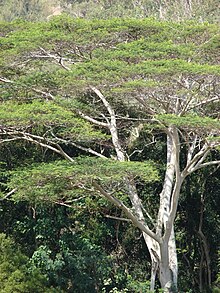| Falcataria | |
|---|---|

| |
| Falcataria moluccana | |
| Scientific classification | |
| Kingdom: | Plantae |
| Clade: | Tracheophytes |
| Clade: | Angiosperms |
| Clade: | Eudicots |
| Clade: | Rosids |
| Order: | Fabales |
| Family: | Fabaceae |
| Subfamily: | Caesalpinioideae |
| Clade: | Mimosoid clade |
| Genus: | Falcataria (I.C.Nielsen) Barneby & J.W.Grimes (1996)[1] |
| Species[2] | |
| |

Falcataria is a genus of flowering plants in the family Fabaceae. It belongs to the monophyletic Mimosoid clade[1][3] in the subfamily Caesalpinioideae.[3] The genus has three species previously classified in the Falcataria section of the genus Paraserianthes by I.C. Neilsen. The distribution of these closely related species within the genus Falcataria links the wet tropics of north-east Australia to New Guinea, the Moluccas, Bismarck Archipelago, and the Solomon Islands east of Wallace's line similar to other plant taxa from the region.[4]
- ^ a b "Falcataria (I. C. Nielsen) Barneby & J. W. Grimes". Germplasm Resources Information Network. United States Department of Agriculture. 1999-03-05. Archived from the original on 2011-06-05. Retrieved 2010-02-28.
- ^ Falcataria (I.C.Nielsen) Barneby & J.W.Grimes. Plants of the World Online. Retrieved 24 August 2023.
- ^ a b Cite error: The named reference
6subfamilieswas invoked but never defined (see the help page). - ^ Gillian K. Brown; Daniel J. Murphy; Pauline Y. Ladiges (2011). "Relationships of the Australo-Malesian genus Paraserianthes (Mimosoideae: Leguminosae) identifies the sister group of Acacia sensu stricto and two biogeographical tracks". Cladistics. 27 (4): 380–390. doi:10.1111/j.1096-0031.2011.00349.x. PMID 34875795. S2CID 85416700.